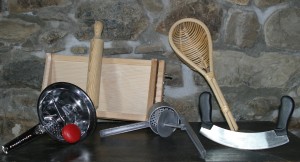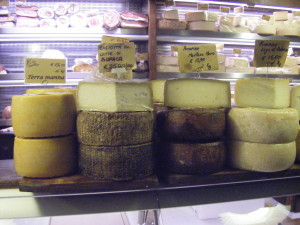Special utensils may be of use in making some of the dishes. The passapatate (center bottomof the photo) is for forcing potatoes or various other ingredients either into a mashed form, or, as in one recipe, to make thick spaghetti-like shapes.
Then there is the mezzaluna or ‘half moon’ (bottom right of the photo), for chopping (see  the recipe for Crostoni). The passaverdura (bottom left) is used to reduce cooked vegetables to a creamy consistency but, unlike the electric-powered liquidizer, it leaves the fibrous material out of the final mixture. The chitarra (left, against the wall) is used for cutting pasta, and has a series of wires upon which the pasta dough is placed and then, using a rolling pin, forced through the wires in order to cut it into its final form. See the recipe for Maccheroni alla chitarra, where the pasta should be prepared with the chitarra, of course, if you have it available.
the recipe for Crostoni). The passaverdura (bottom left) is used to reduce cooked vegetables to a creamy consistency but, unlike the electric-powered liquidizer, it leaves the fibrous material out of the final mixture. The chitarra (left, against the wall) is used for cutting pasta, and has a series of wires upon which the pasta dough is placed and then, using a rolling pin, forced through the wires in order to cut it into its final form. See the recipe for Maccheroni alla chitarra, where the pasta should be prepared with the chitarra, of course, if you have it available.
When using Parmesan cheese, it is vital to use only the best quality, and avoid the already grated cheese in jars or plastic containers. Buy a piece of Parmesan cheese and grate it fresh for each dish that requires it.
The same is true for prosciutto (Parma ham). Make sure it is of the best quality: it should be seasoned, but not too salty. Buy the best you can find.
When you cook pasta, it is essential to remove it from the boiling water when still al dente. That is when it has a little ‘bite’ left, and is definitely not soft. Take care not to overcook any pasta, and look on the packet for the recommended cooking times. Cook it uncovered (although you will leave the cover on the pan for a while just after adding the pasta to boiling water in order to bring it back to the boil quickly). Before adding the pasta, always ensure that the water is boiling briskly, and the pan is large and has plenty of water. Do not cook the pasta before preparing the sauce: on the contrary, always make sure that the sauce is ready before putting the pasta into the boiling water. Once cooked, pasta has to be drained quickly, mixed with its sauce, served and eaten immediately – otherwise it overcooks in the serving dish, and could as well be thrown away.
Olive oil should always be of the best quality. So, use extra virgin, first cold pressing if possible.
Growing your own herbs is another way to ensure a supply of fresh rosemary, basil, sage and so on. Some plants can be grown indoors or at least purchased as live plants and kept indoors until you are ready to use them – they may not thrive in the longer term.
As for the wine, let us give you and old proverb from Nicola Mastropietro, grandfather of our friend Susan:
Vino vinelle
se’ sabrit’e belle
se’ nat’al fresche
me fa’ parla’ tedesche.
‘Na mane te prentre
una t’abraze
a la salute…
te men’a corde.
Which could be (roughly…) translated as “Wine, nice wine, you are tasty and beautiful, you were born in the coolness, you make me speak foreign languages. One hand holds you, one hand hugs you, to your health…. it goes down to the heart”. When a recipe calls for wine, use only wine that is good to drink, and taste it to make sure that it is not `corked` – that is to say, check that it does not taste of cork, a problem that might occur when wine reacts with the cork in the bottle during storage.
